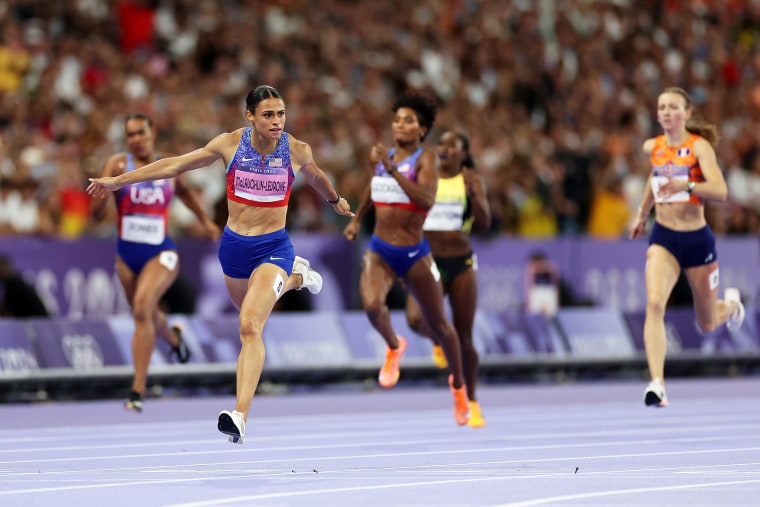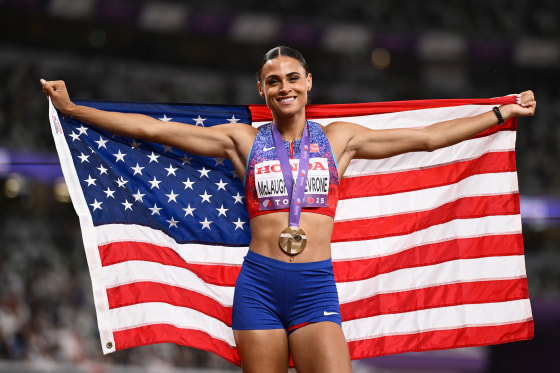Any list of the most dominant active American athletes isn't complete without a mention of Sydney McLaughlin-Levrone.
For nearly five years, the suspense of watching McLaughlin-Levrone race has hinged not on whether she will win, but whether she will break one of track and field’s records while doing it. McLaughlin-Levrone, 26, lowered the world record and won gold medals in her specialty, the 400-meter hurdles, so often and by so much that she eventually went looking for other challenges — and subsequently nearly set the world record in a new event this year, too.
At track's most recent world championships, on Sept. 15 McLaughlin-Levrone won the 400-meter world title while coming within .18 of a second of breaking its world record, which has stood for 40 years, too.
That versatility means her options remain open in the lead-up to the 2028 Summer Olympics in Los Angeles.
She and her coach, Bobby Kersee, have "definitely floated the idea of some sort of a double, what that looks like," McLaughlin-Levrone told NBC News. "I think the options are still open. There’s a lot of different directions you could go with it."
A favorable Olympic schedule that would allow for enough time for recovery between multiple events is one of the few apparent constraints.
Since 2022, when McLaughlin-Levrone became the first woman to run the 400-meter hurdles in less than 51 seconds — winning the 2022 world championship in 50.68 seconds, a record she lowered to 50.37 in last year's Olympic final — one of the sport's most-speculated topics concerned whether she would ever attempt to double up both the open 400, and the 400-meter hurdles, at either a world championship or the Olympics.
But in the years since, as she has become world-class in the 200 meters as well, the possibilities for a potential double have broadened. Since April 2021, she is 42-1 when racing either the 200 meters, 400 meters or 400-meter hurdles. At the Olympics in 2021 and 2024, and track and field’s world championships in 2022, 2023 and 2025, she has been unbeaten while winning a combined eight gold medals, including relays.
Realizing how close she was to breaking the 400-meter world record in September makes her want to “pursue that a little bit more,” she said. “I definitely would love to run some more 200s in the future. I was hoping in 2024 to dip under 22 (seconds). ... So maybe something like that. And then, you know, maybe going back to the hurdles for a little bit. I’m not really sure what the landscape fully looks like, but I think the exciting part is that there’s options and opportunity.”
Those options could even extend to the long jump. When she recently raised the idea of trying the event for the first time since she was a high schooler in New Jersey, "it was somewhat jokeable," she said, "but I was being serious."
McLaughlin-Levrone is close with the American record-holder, Jackie Joyner-Kersee, whose husband, Bobby, has coached McLaughlin-Levrone since 2020.
“I really would love to get back to that if, you know, if it makes sense,” she said. “I mean, Bobby has coached Jackie to the American record. But like I said, I want to finish my career with the best personal scorecard I possibly can. And I think that’s something that definitely needs an update.”
Improving her "personal scorecard" continues to fuel McLaughlin-Levrone's ambitions, even when she has regularly outdistanced her rivals.
In the 200, both she and her coach believe running well under 22 seconds is possible. Both, too, have wondered how much faster she could have run in the 400 at September's world championships had rain not left the Tokyo track wet, and had an awkward gap in timing not left McLaughlin-Levrone and the other finalists waiting, cold, for nearly 10 minutes for the race to begin.

She "definitely" thinks she can run faster in the 400, while becoming the first woman to run under 50 seconds in the 400 hurdles "is always in the back of my mind," she said.
"Those are both things that I often think about and look at," McLaughlin-Levrone said. "Of course, you can’t pursue everything at one time. You got to take it one at a time and allow your body to really gear up to race some of these really fast races. But yeah, I definitely still think I’d love to dip under 50 at some point, if time permits, and run faster in the 400 and try to go for that longstanding record."
With no global world championship on the schedule in 2026, next season will allow McLaughlin-Levrone some flexibility to go after some of those goals. Track and field’s global governing body, World Athletics, is debuting a new season-ending event dubbed the “Ultimate Championship," for which McLaughlin-Levrone and her fellow gold medalists from the Paris Olympics and world championship have automatically qualified.
"It'll be exciting to see it for the first time, and all that it entails," she said. "I think the first meet is always, you know, there's learning curves."
Kersee has always been strategic about how he structures McLaughlin-Levrone's season, likening her to a sports car that needs careful tuning, not constant running. It was why it was notable in 2024 when she signed up to compete in a startup league, called Grand Slam Track, that promised its elite competitors would take part in four springtime meets.
Signing McLaughlin-Levrone lent credibility to Grand Slam Track, and the league positioned her as one of its faces by having her appear at the introductory event alongside founder and former Olympic champion Michael Johnson.
Yet Grand Slam Track only made it three meets before a funding shortfall led to the cancellation of its fourth. By August, it still owed athletes around $13 million in unpaid performance earnings. It has since paid out about half that amount to athletes, according to an agent whose clients were owed money. Grand Slam Track did not immediately respond to a request for comment.
Johnson has stated he is "confident about the future of Grand Slam Track," but would McLaughlin-Levrone want to even take part again if the league survives for a second season?
"It's a good question," she said. "I think we'd have to see how it comes back and what the security of it looks like. I think there was a lot of athletes that loved the model, loved what they were able to put out from a product standpoint, but of course, you have to be able to sustain that. And so, we would honestly just have to see what that sustainability looks like before venturing into anything moving forward."

